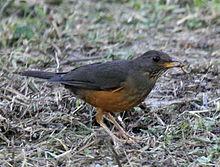Olive thrush, a Southern African bird
Botanical Name: Turdus olivaceus
Afrikaans name: Olyflyster
This thrush can be found in the picnic area and riverine bush of Fernkloof Nature Reserve - foraging on the ground and in leaf litter.
The Olive Thrush (Turdus Olivaceus) is a Southern African bird that belongs to the Muscicapidae bird family group which includes birds such as Thrushes, Robins, Chats and Old World Flycatcher. They occur in East African highlands from Tanzania and Zimbabwe in the North to the Cape of Good Hope in South. Also along the escarpment, Eastern Mpumalanga, Eastern Limpopo, Eastern Cape and along the coastal region from Cape Town Northwards, in fact it is the 8th most common bird in Cape Town. Their main habitat is in the forests and woodlands, but has locally adapted to parks and large gardens in suburban areas.
Key ID Features:
- Orange flanks
- Brown (dull) Eye-ring
- Yellow bill with dark base to upper mandible
- Throat usually white with dark streaking.
- Throat appears more heavily streaked
The Olive Thrush (Turdus Olivaceus) has a height of 24 cms and weighs around 66 gms and is a monogamous bird which means that the bird finds and breeds with one partner for the rest of its life. The female builds the nest solely in about 10 days, consisting of a large, moist bowl mad of grass stems, twigs, earth, wet leaves and moss, lined with plant stems, fibres, tendrils and bracken. They typically build in the fork of a tree branch from 3 – 16 metres above ground. Egg-laying is basically all year round, peaking from August to December. The female lays between2-3 eggs, which she will incubate for about 14 days, occasionally leaving the nest for up to an hour to forage. The chicks are feed mainly by the female for the first 2 days, then the male will pass food to the female for the first few days. Later both parents will feed the young and about 16 days old when they can barely fly will they attempt to leave the nest; they remain dependent of their parents for up to 2 months further.The Olive Thrush (Turdus Olivaceus) has a height of 24 cms and weighs around 66 gms and is a monogamous bird which means that the bird finds and breeds with one partner for the rest of its life. The female builds the nest solely in about 10 days, consisting of a large, moist bowl mad of grass stems, twigs, earth, wet leaves and moss, lined with plant stems, fibres, tendrils and bracken. They typically build in the fork of a tree branch from 3 – 16 metres above ground. Egg-laying is basically all year round, peaking from August to December. The female lays between2-3 eggs, which she will incubate for about 14 days, occasionally leaving the nest for up to an hour to forage. The chicks are feed mainly by the female for the first 2 days, then the male will pass food to the female for the first few days. Later both parents will feed the young and about 16 days old when they can barely fly will they attempt to leave the nest; they remain dependent of their parents for up to 2 months further.
The Olive Thrush is mainly seen singly or in pairs in the wild.
Call us and schedule your listing today! Contact Us
Copyright © 2025 Hermanus Online Magazine. Web Development by Jaydee media.

